- Accueil
- Pages cachées
- 06 DECEMBRE 2023 NEWS
06 DECEMBRE 2023 NEWS
INSTITUT SUPERIEUR D'ANTHROPOLOGIE
INSTITUT OF ANTHROPOLOGY
COURS ONLINE – COURS A DISTANCE
INSCRIPTIONS OUVERTES
REGISTER NOW
JAPON – 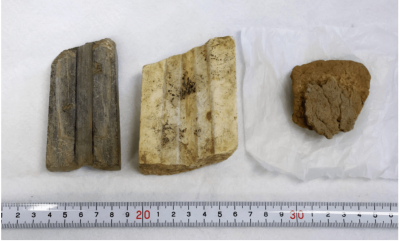 Yoshinogari - At the Yoshinogari Ruins in the western prefecture of Saga, relics including stone casting molds for bronze artifacts have been found. These molds may be the oldest of their kind in Japan, the Saga prefectural announced on Monday. One of the molds could date back to around 200 BC, according to the local government. This date marks a unique time in Japanese history: Yayoi period. The period of Japanese history called the Yayoi Period spanned from 300 BC through 250 BC. The discoveries between September and October at the Yoshinogari ruins followed the finding in April of a stone coffin tomb believed to have belonged to a person of high status in an area of the site. The enigmatic coffin prompted experts and archaeology buffs to wonder whose burial site it is however it was announced in June that no human bones or burial accessories were found that could yield clues as to the individual’s identity or the exact burial period.The latest excavation of what is called the “mystery area,” which could not be surveyed because a shrine had been there, found three items — casting molds made of serpentinite and quartz-porphyry, as well as a clay vessel used as a container for molten metal. The molds, possibly used for casting swords and spears, were found within a range of about 5 meters northwest to about 10 meters south-southwest from where the stone coffin was discovered, according to the prefecture. Bronze Age metal tools were formed using moulds to shape the molten metal into the desired form. The technology for moulding bronze improved through the Bronze Age. Initially, items were cast by pouring the melted bronze into hollowed out stone moulds. By the Middle Bronze Age, people had invented two part moulds, where two hollowed stones were put together and metal was poured into a gap at the top. This allowed for sophisticated objects like axes and spearheads to be produced.
Yoshinogari - At the Yoshinogari Ruins in the western prefecture of Saga, relics including stone casting molds for bronze artifacts have been found. These molds may be the oldest of their kind in Japan, the Saga prefectural announced on Monday. One of the molds could date back to around 200 BC, according to the local government. This date marks a unique time in Japanese history: Yayoi period. The period of Japanese history called the Yayoi Period spanned from 300 BC through 250 BC. The discoveries between September and October at the Yoshinogari ruins followed the finding in April of a stone coffin tomb believed to have belonged to a person of high status in an area of the site. The enigmatic coffin prompted experts and archaeology buffs to wonder whose burial site it is however it was announced in June that no human bones or burial accessories were found that could yield clues as to the individual’s identity or the exact burial period.The latest excavation of what is called the “mystery area,” which could not be surveyed because a shrine had been there, found three items — casting molds made of serpentinite and quartz-porphyry, as well as a clay vessel used as a container for molten metal. The molds, possibly used for casting swords and spears, were found within a range of about 5 meters northwest to about 10 meters south-southwest from where the stone coffin was discovered, according to the prefecture. Bronze Age metal tools were formed using moulds to shape the molten metal into the desired form. The technology for moulding bronze improved through the Bronze Age. Initially, items were cast by pouring the melted bronze into hollowed out stone moulds. By the Middle Bronze Age, people had invented two part moulds, where two hollowed stones were put together and metal was poured into a gap at the top. This allowed for sophisticated objects like axes and spearheads to be produced.
Japan’s possibly oldest stone molds for bronze casting discovered at Yoshinogari ruins - Arkeonews
GRECE – 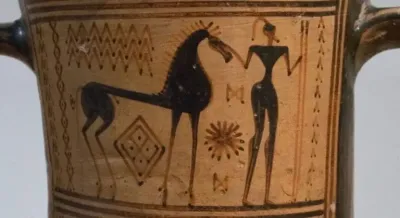 Kerameikos - Discovered in Kerameikos, Athens at a gate called Dipylon at the entrance to an ancient cemetery there, the maker of this gigantic piece, along with all the others who created ancient Greek masterpieces of pottery, has always been assumed to be male. Indeed, the artisan here is always referred to by historians as the “Dipylon Master.” But what if the creator of this striking grave marker, and many other pieces of pottery, was actually female? Sarah Murray, a classical archaeologist from the University of Toronto, along with two of her undergraduate students, are questioning long-held beliefs in this arena. They believe that not only did females participate in the making of artistic pottery but that they were primarily responsible for the creation of ceramics in the early Greek Iron Age, which lasted from 1050 BC to 700 BC. Unfortunately, there are no written records extant which date back to that era. Indeed, pottery itself serves as much of the historical record of these times in Greece. “Pottery is the anchor of everything we say about the society—but I think that’s problematic,” Murray says in a new article in the American Journal of Archaeology. “No one had really thought that women were involved in making this pottery. There was no argument. It was just taken as the default,” the researcher adds. Indeed, most indisputable historical records from all the eras in Greek history show that it was for themes part a clearly male-dominated society. However, Murray and her team posit the theory that, due to huge societal shifts which took place between the preceding Bronze Age, which represented a high point in artistic expression of every kind in Greece, and the Iron, women may have taken on new roles and begun to create pottery as well. The Iron Age differed from the previous era in many ways — there was a measurable drop in population from the previous Bronze Age, something which, Murray says, leads to women stepping into the breach and beginning to create pottery themselves. This situation may not have continued into what is called the Archaic Age, with its rebound in population and the concomitant social classifications which accompanied it — but for this time period, it is entirely possible, according to Murray, that females put their mark on the Ancient Greek art of fine pottery. Additionally, as seen on the Dipylon vase above, there is a sudden and marked emphasis on geometric patterns such as zigzags and diamonds, representing an enormous change from prior pottery decoration. Murray believes that this may actually be a recreation of the geometric patterns used in weaving — which was purely a female art at the time. “The fact that the style seems to be inspired by textiles is kind of like the big, blaring horn,” she says in the American Journal of Archaeology article. “Women are almost always the weavers.” The fact that the Dipylon vase itself portrays mourners is another tell for Murray, who explains that women always had played a huge role in funeral rituals, including preparing the bodies and even being professional mourners, roles which go across nearly all human civilizations. Additionally, most Iron Age pottery carries motifs of women’s daily lives — weaving and doing other typically female chores. Later pottery from the Archaic period often was decorated with battle scenes and even poetry, retelling epic battles. At the present time there is research being undertaken to closely examine pottery for impressions of the fingerprints of the ancient potters, which may shed light on the gender of the person who created the piece. Julie Hruby, a classicist from Dartmouth College, is zeroing in on using this new technology to finally determine who these ancient potters might be, creating a new method for analyzing prints. She states “I would be surprised if I found fingerprint evidence that refuted what was in (Murray’s) article.”
Kerameikos - Discovered in Kerameikos, Athens at a gate called Dipylon at the entrance to an ancient cemetery there, the maker of this gigantic piece, along with all the others who created ancient Greek masterpieces of pottery, has always been assumed to be male. Indeed, the artisan here is always referred to by historians as the “Dipylon Master.” But what if the creator of this striking grave marker, and many other pieces of pottery, was actually female? Sarah Murray, a classical archaeologist from the University of Toronto, along with two of her undergraduate students, are questioning long-held beliefs in this arena. They believe that not only did females participate in the making of artistic pottery but that they were primarily responsible for the creation of ceramics in the early Greek Iron Age, which lasted from 1050 BC to 700 BC. Unfortunately, there are no written records extant which date back to that era. Indeed, pottery itself serves as much of the historical record of these times in Greece. “Pottery is the anchor of everything we say about the society—but I think that’s problematic,” Murray says in a new article in the American Journal of Archaeology. “No one had really thought that women were involved in making this pottery. There was no argument. It was just taken as the default,” the researcher adds. Indeed, most indisputable historical records from all the eras in Greek history show that it was for themes part a clearly male-dominated society. However, Murray and her team posit the theory that, due to huge societal shifts which took place between the preceding Bronze Age, which represented a high point in artistic expression of every kind in Greece, and the Iron, women may have taken on new roles and begun to create pottery as well. The Iron Age differed from the previous era in many ways — there was a measurable drop in population from the previous Bronze Age, something which, Murray says, leads to women stepping into the breach and beginning to create pottery themselves. This situation may not have continued into what is called the Archaic Age, with its rebound in population and the concomitant social classifications which accompanied it — but for this time period, it is entirely possible, according to Murray, that females put their mark on the Ancient Greek art of fine pottery. Additionally, as seen on the Dipylon vase above, there is a sudden and marked emphasis on geometric patterns such as zigzags and diamonds, representing an enormous change from prior pottery decoration. Murray believes that this may actually be a recreation of the geometric patterns used in weaving — which was purely a female art at the time. “The fact that the style seems to be inspired by textiles is kind of like the big, blaring horn,” she says in the American Journal of Archaeology article. “Women are almost always the weavers.” The fact that the Dipylon vase itself portrays mourners is another tell for Murray, who explains that women always had played a huge role in funeral rituals, including preparing the bodies and even being professional mourners, roles which go across nearly all human civilizations. Additionally, most Iron Age pottery carries motifs of women’s daily lives — weaving and doing other typically female chores. Later pottery from the Archaic period often was decorated with battle scenes and even poetry, retelling epic battles. At the present time there is research being undertaken to closely examine pottery for impressions of the fingerprints of the ancient potters, which may shed light on the gender of the person who created the piece. Julie Hruby, a classicist from Dartmouth College, is zeroing in on using this new technology to finally determine who these ancient potters might be, creating a new method for analyzing prints. She states “I would be surprised if I found fingerprint evidence that refuted what was in (Murray’s) article.”
Female Artisans May Have Created Archaic Pottery, Researcher Says - GreekReporter.com
NORVEGE – 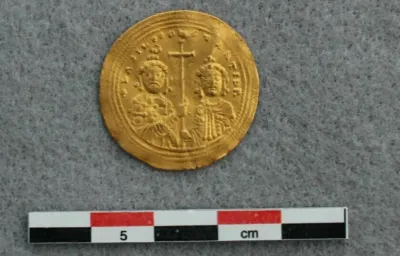
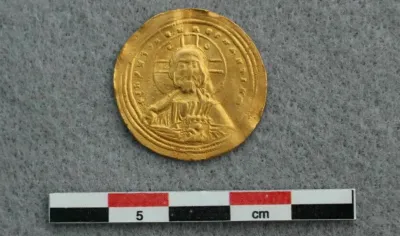 Vestre Slidre - “It’s difficult to brag about finds so much because it sounds absolutely incredible. But that's what it is,” says May-Tove Smiseth, the county archaeologist for Innlandet County in Eastern Norway. Even she did not believe the metal detectorist who contacted her to report that he had found a gold coin up in the mountains in Vestre Slidre in the Valdres region. “ That he found a gold coin on a random trip in the mountains is completely surreal,” she says. “This is unusual and exceptional. From what we’ve found out, the coin is the only one of its kind in Norway.” And it was true. It was a gold coin, originating from what we now refer to as Istanbul, Turkey, which was known as Constantinople at that time. The coin is a Byzantine histamenon nomisma. These were introduced in Byzantium around 960 AD in what was then the eastern part of the Roman Empire.One side of the coin is stamped with an image of Christ holding the Bible. On the other side, the two emperors Basil II and Constantine VIII are most likely depicted. The two brothers jointly ruled in Byzantium for almost 50 years, from 976-1025.Presumably, the coin was minted early in the 11th century. The exact date is difficult to determine, but the dotted border suggests that it was late in Basil’s and Constantine’s reign, Smiseth explains. The coin also bears two inscriptions. In Latin, it says Jesus Christ, King of those who rule, and in Greek, it reads Basil and Constantine, emperors of the Romans. In some way or another, the coin found its way to Valdres in Norway. Perhaps it was originally part of the treasures that Harald Hardrada amassed after serving in the Varangian Guard for the Byzantine emperor in 1034? The Varangian Guard consisted of Scandinavian mercenaries who served as bodyguards and were known as being fearless and strong.
Vestre Slidre - “It’s difficult to brag about finds so much because it sounds absolutely incredible. But that's what it is,” says May-Tove Smiseth, the county archaeologist for Innlandet County in Eastern Norway. Even she did not believe the metal detectorist who contacted her to report that he had found a gold coin up in the mountains in Vestre Slidre in the Valdres region. “ That he found a gold coin on a random trip in the mountains is completely surreal,” she says. “This is unusual and exceptional. From what we’ve found out, the coin is the only one of its kind in Norway.” And it was true. It was a gold coin, originating from what we now refer to as Istanbul, Turkey, which was known as Constantinople at that time. The coin is a Byzantine histamenon nomisma. These were introduced in Byzantium around 960 AD in what was then the eastern part of the Roman Empire.One side of the coin is stamped with an image of Christ holding the Bible. On the other side, the two emperors Basil II and Constantine VIII are most likely depicted. The two brothers jointly ruled in Byzantium for almost 50 years, from 976-1025.Presumably, the coin was minted early in the 11th century. The exact date is difficult to determine, but the dotted border suggests that it was late in Basil’s and Constantine’s reign, Smiseth explains. The coin also bears two inscriptions. In Latin, it says Jesus Christ, King of those who rule, and in Greek, it reads Basil and Constantine, emperors of the Romans. In some way or another, the coin found its way to Valdres in Norway. Perhaps it was originally part of the treasures that Harald Hardrada amassed after serving in the Varangian Guard for the Byzantine emperor in 1034? The Varangian Guard consisted of Scandinavian mercenaries who served as bodyguards and were known as being fearless and strong.
SRI LANKA – 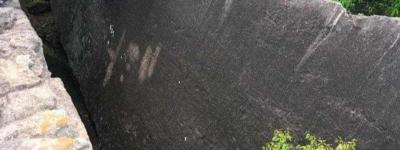 Dimbulagala - Sri Lanka's Department of Archeology says that the process of copying the characters and symbols from the country's single largest ever stone inscription, discovered in Dimbulagala, is in its final stages. The largest stone inscription found in Sri Lanka so far,was discovered on Polonnaruwa’s historic Dimbulagala Aranya Senasana hills. The stone inscription is about 45 feet long and 18 feet high, and it believed that it was carved somewhere between 1 & 2 BC. Experts say that the characters and symbols in the stone inscription are those that belong to the early Brahmi script.
Dimbulagala - Sri Lanka's Department of Archeology says that the process of copying the characters and symbols from the country's single largest ever stone inscription, discovered in Dimbulagala, is in its final stages. The largest stone inscription found in Sri Lanka so far,was discovered on Polonnaruwa’s historic Dimbulagala Aranya Senasana hills. The stone inscription is about 45 feet long and 18 feet high, and it believed that it was carved somewhere between 1 & 2 BC. Experts say that the characters and symbols in the stone inscription are those that belong to the early Brahmi script.
Sri Lanka to start deciphering Dimbulagala stone inscription soon (newsfirst.lk)
ISRAEL – Jerusalem - Greetings from Antiochus Epiphanes: The earliest evidence to date for the use of ceramic rooftiles in the Land of Israel has been uncovered in the City of David National Park surrounding the walls of the Old City of Jerusalem. Sixteen Hellenistic-period rooftile fragments dating from the 2nd century BCE were found in archaeological excavations The finds, dated to the time of the Greek Seleucid King Antiochus IV, the oppressor known from the story of Hanukkah, will be exhibited for the first time on Monday, 11th December 2023, at the Israel Antiquities Authority Conference “In Those Days At This Time–The Hasmoneans are Coming.”Ceramic roofing tiles were invented in Greece as early as the 7th Century BCE, with their durability and resistance to water, specifically rainwater and precipitation, gaining them a positive reputation and ensuring their rapid adoption in neighboring areas. However, 500 years went by until they began to appear in the material culture of the Land of Israel. In fact, it appears that the person who brought them to Israel was none other than Antiochus IV Epiphanes – known to all of us from the story of Hanukkah. “The representatives of the Seleucid King, Antiochus IV, who reigned over vast areas from Syria to Persia, brought the knowledge and tradition of constructing tiled roofs from Seleucid-controlled Syria,” say the researchers. According to the story in the book of the Maccabees, in 168 BCE, Antiochus IV undertook a military expedition to Jerusalem, which led to the outbreak of the renown Maccabean Revolt. In order to establish his control of the city, Antiochus constructed a mighty fortress that was known as the “Acra.” The Greek soldiers residing in the fortress continued to rule the city after the Maccabean cleansing of the Jerusalem Temple, and according to the descriptions in the books of the Maccabees and in the later writings of Flavius Josephus, the fortress embittered the lives of the Jewish residents in the city and the Temple. Despite several descriptions of the fortress in the Jewish and external literary sources, its exact location within the city still remains a puzzle debated by scholars.
VIDEO = https://www.israelnationalnews.com/news/381505
CHINE - 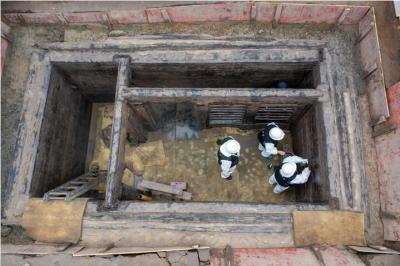 Chongqing - A well-preserved tomb, dating back to the Western Han Dynasty (202 BC-25 AD), with a clear recorded year has been discovered in Wulong District of southwest China's Chongqing Municipality, the Chongqing Cultural Relics and Archaeology Research Institute said Tuesday. This archaeological project is a rescue excavation and protection work carried out to forge cooperation with the Baima project, the last of a cascade of hydropower stations on the section of the Wujiang River in Chongqing. With the approval of the National Cultural Heritage Administration, the Chongqing Cultural Relics and Archaeology Research Institute set up a work team of more than 20 people from different archaeology research institutes and universities to excavate the site in March this year. According to Huang Wei, the leader of the archaeological project, a collection of tombs dating from the Han Dynasty (202 BC-220 AD) to the Six Dynasties period (222-589) were newly discovered as part of this project. Among them, the tomb dating back to the Western Han Dynasty was the most important, and more than 600 precious cultural relics such as lacquerware, wood ware, bamboo ware, pottery and bronze ware were unearthed from the tomb. Due to the tomb being filled with water throughout the year, it remains undisturbed and unharmed, and the funerary objects in the tomb are well preserved. "What is exciting about this discovery is not just the large number of unearthed artifacts but also the list of burial items containing a precise year record, which has been verified as 193 BC, providing clarity on the tomb's burial timeframe. An unearthed jade ware from the tomb shows the prominent position of the tomb owner," Huang said. The list of burial items found in the tomb is complete and clearly records the name, quantity and size of the funerary objects. The tomb discovered this time is the one containing the largest quantity of lacquered wood and bamboo wares ever found at one time in the upper reaches of the Yangtze River in China, said Bai Jiujiang, head of the Chongqing Cultural Relics and Archaeology Research Institute. Based on publicly available information, it is also the earliest tomb of the Western Han Dynasty found in China, with a clear recorded year, according to Bai. This is a major archaeological discovery regarding the Qin and Han Dynasties in the Wujiang River Basin, offering physical evidence and important basic research materials for future study of burial customs and the comparative analysis of famous artifacts from the early Western Han Dynasty, according to the archaeologists.
Chongqing - A well-preserved tomb, dating back to the Western Han Dynasty (202 BC-25 AD), with a clear recorded year has been discovered in Wulong District of southwest China's Chongqing Municipality, the Chongqing Cultural Relics and Archaeology Research Institute said Tuesday. This archaeological project is a rescue excavation and protection work carried out to forge cooperation with the Baima project, the last of a cascade of hydropower stations on the section of the Wujiang River in Chongqing. With the approval of the National Cultural Heritage Administration, the Chongqing Cultural Relics and Archaeology Research Institute set up a work team of more than 20 people from different archaeology research institutes and universities to excavate the site in March this year. According to Huang Wei, the leader of the archaeological project, a collection of tombs dating from the Han Dynasty (202 BC-220 AD) to the Six Dynasties period (222-589) were newly discovered as part of this project. Among them, the tomb dating back to the Western Han Dynasty was the most important, and more than 600 precious cultural relics such as lacquerware, wood ware, bamboo ware, pottery and bronze ware were unearthed from the tomb. Due to the tomb being filled with water throughout the year, it remains undisturbed and unharmed, and the funerary objects in the tomb are well preserved. "What is exciting about this discovery is not just the large number of unearthed artifacts but also the list of burial items containing a precise year record, which has been verified as 193 BC, providing clarity on the tomb's burial timeframe. An unearthed jade ware from the tomb shows the prominent position of the tomb owner," Huang said. The list of burial items found in the tomb is complete and clearly records the name, quantity and size of the funerary objects. The tomb discovered this time is the one containing the largest quantity of lacquered wood and bamboo wares ever found at one time in the upper reaches of the Yangtze River in China, said Bai Jiujiang, head of the Chongqing Cultural Relics and Archaeology Research Institute. Based on publicly available information, it is also the earliest tomb of the Western Han Dynasty found in China, with a clear recorded year, according to Bai. This is a major archaeological discovery regarding the Qin and Han Dynasties in the Wujiang River Basin, offering physical evidence and important basic research materials for future study of burial customs and the comparative analysis of famous artifacts from the early Western Han Dynasty, according to the archaeologists.
Rare Western Han Dynasty tomb found in southwest China - China.org.cn
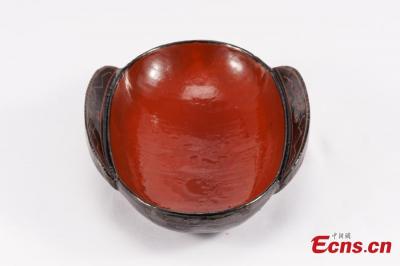
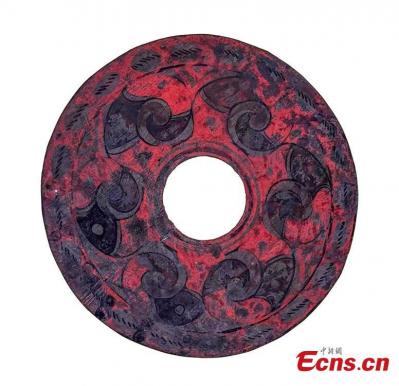
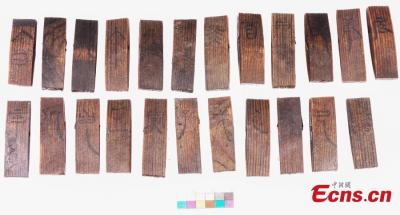
More than 600 pieces of cultural relics such as lacquerware, wood ware, bamboo ware pottery and bronze ware were excavated from the well-preserved tomb.
Western Han Dynasty tomb found in Chongqing - People's Daily Online
FRANCE – Vichy - La structuration médiévale de la ville de Vichy reste encore aujourd’hui très largement méconnue. Une population se regroupe sous l’autorité d’un seigneur « de Vichy », au milieu du XIIIe siècle, sur le rocher dit « des Célestins ». Au milieu du XIVe siècle, Vichy, jusqu’alors auvergnate, devient progressivement une possession bourbonnaise, grâce à de nombreux achats et échanges de droits seigneuriaux. La ville se développe alors autour d’un pôle castral. Il faut attendre le début XVe siècle pour que cet espace urbain soit fortifié (1409). Une portion de cet ouvrage défensif a été appréhendée durant l’opération archéologique de 2023. Un mur de courtine, couronnée de créneaux, a ainsi été reconnu sur plusieurs mètres. Il se conforme aux importantes dénivellations du rocher, qui est ici identifié comme un dépôt de travertin. En contrebas de cet ouvrage défensif, la découverte de dépôts alluviaux confirme la présence toute proche, voire affleurante, de l’Allier. La fouille a mis en évidence deux bâtiments, datés de la fin du XVe siècle-début du XVIe siècle. Ces derniers prennent place en bordure du rocher, à l’extérieur de la ville fortifiée, contre le mur de courtine. Leur simple reconnaissance témoigne de l’abandon partiel des aménagements fortifiés de la ville, avec une colonisation des remparts par diverses constructions. Ces dernières sont alors possibles en raison d’un recul progressif de l’Allier, vers sa rive sud, attesté à partir de la fin du XVe siècle, qui laisse des espaces vierges de toute construction à exploiter. La mitoyenneté de ces deux bâtiments desservis par l’actuelle rue Verrier a été pensée dès leurs construction (chaine d’angle). Le premier bâtiment est conservé sur plus de 10 m de hauteur. Il se développe autour d’une tour carré, renfermant un escalier à vis en pierre de taille qui dessert plusieurs niveaux de plancher. Au rez-de-chaussée, une vaste pièce - une cuisine - est dotée d’une cheminée centrale encadrée par deux petits placards. Le second bâtiment, conservé sur deux niveaux, est accessible depuis la rue grâce à une porte piétonne. Le rez-de-chaussée, doté d’une cheminée, se structure autour d’un pilier central. Ce bâtiment, repose sur une cave, voutée en berceau, partiellement enterrée, contrainte par la topographie du site et par le parcellaire urbain. Construction soignée, cette cave donne sur la rue via une annexe. Jusqu’alors reconnue comme une simple trappe à charbon, cette annexe est aujourd’hui identifiée comme une descente d’escalier. Les représentations graphiques anciennes associent cette dernière à un appentis.
Actualité | Le Castel Franc à Vichy : de l’enceinte urbaine... | Inrap